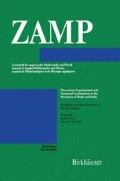Abstract
By way of background, it may be remarked that for a body consisting of finitely many particles, several different derivations of Lagrange’s equations can be found in the dynamics literature.1 These include: derivations proceeding from Newton’s second law by an unenlightening manipulation of partial derivatives; those employing the principle of virtual work; and those appealing to variational principles.
Access this chapter
Tax calculation will be finalised at checkout
Purchases are for personal use only
Preview
Unable to display preview. Download preview PDF.
References
E. T. Whittaker, A Treatise on the Analytical Dynamics of Particles and Rigid Bodies. 3rd edn., University Press, Cambridge 1927.
J. L. Synge and B. A. Griffith, Principles of Mechanics. 3rd edn., McGraw Hill, Inc. 1959.
L. A. Pars, A Treatise on Analytical Dynamics. John Wiley & Sons, Inc. 1968.
D. T. Greenwood, Principles of Dynamics. 2nd edn., Prentice-Hall, Inc. 1988.
H. Goldstein, Classical Mechanics. 2nd edn., Addison-Wesley Publ. Co. 1980.
R. M. Rosenberg, Analytical Dynamics of Discrete Systems. Plenum Press 1977.
C. Lanczos, The Variational Principles of Mechanics. University of Toronto Press 1949, Dover reprint 1986.
J. L. de Lagrange, Méchanique Analitique. La Veuve Desaint, Paris 1788; See Vols. 11 and 12 of Oeuvres (edited by J.-A. Serret and G. Darboux), Gauthier-Villars et Fils, Paris 1888 and 1889, respectively, and reprinted by Georg Olms Verlag, Hildesheim and New York 1973.
C. Truesdell and R. A. Toupin, The Classical Field Theories. In S. Flügge’s Handbuch der Physik, III/1, pp. 226–858, Springer-Verlag 1960.
J. L. Synge and A. Schild, Tensor Calculus. University of Toronto Press 1949, Dover reprint 1978.
I. S. Sokolnikoff, Tensor Calculus: Theory and Applications to Geometry and Mechanics of Continua. John Wiley & Sons, Inc. 1964.
C.-C. Wang, Mathematical Principles of Mechanics and Electromagnetism (Part A). Plenum Press, New York 1979.
L. Brillouin, Tensors in Mechanics and Elasticity. Academic Press 1964.
A. J. McConnell, Applications of the Absolute Differential Calculus. Blackie Co. 1931; republished as Applications of Tensor Analysis, Dover 1957.
H. Hertz, The Principles of Mechanics Presented in a New Form (translated by D. E. Jones and J. T. Walley). The Macmillan Co. 1900, Dover reprint 1956.
G. Ricci and T. Levi-Civita, Méthodes de calcul différentiel absolu et leurs applications. Math. Ann. LIV, 125–201 (1900)
Tullio Levi-Civita, Opere matematiche, Vol. 1, 479–559, Nicola Zanichelli Editore, Bologna 1954.
T. Levi-Civita, The Absolute Differential Calculus. Blackie & Son Ltd 1926, Dover reprint 1977.
J. L. Synge, On the geometry of dynamics. Phil. Trans. Roy. Soc. London A226, 31–106 (1927).
J. Casey, Geometrical derivation of Lagrange’s equations for a system of particles. Am. J. Phys. 62, 836–847 (1994).
J. Casey, A treatment of rigid body dynamics. J. Appl. Mech. 50, 905–907 (1983)
J. Casey, A treatment of rigid body dynamics. J. Appl. Mech. 51, 227 (1984).
J. Casey and V. C. Lam, A tensor method for the kinematical analysis of systems of rigid bodies. Mechanism and Machine Theory 21, 87–91 (1986).
J. Casey and V. C. Lam, On the relative angular velocity tensor. J. Mechanism, Trans. & Auto, in Design (Trans. ASME) 108, 399–400 (1986).
J. Casey and V. C. Lam, On the reduction of the rotational equations of rigid body dynamics. Meccanica 22, 41–42 (1987).
C. Truesdell, A First Course in Rational Continuum Mechanics (Vol. 1). 2nd edn., Academic Press, Inc. 1991.
P. R. Halmos, Finite-Dimensional Vector Spaces. Springer-Verlag, New York, Inc. 1974.
P. Chadwick, Continuum Mechanics, John Wiley & Sons, New York.
Author information
Authors and Affiliations
Editor information
Editors and Affiliations
Additional information
Dedicated to Paul M. Naghdi on the occasion of his 70th birthday, whose gifts as a teacher and creator of mechanics have been a source of continual inspiration
Rights and permissions
Copyright information
© 1995 Birkhäuser Verlag Basel/Switzerland
About this chapter
Cite this chapter
Casey, J. (1995). On the advantages of a geometrical viewpoint in the derivation of Lagrange’s equations for a rigid continuum. In: Casey, J., Crochet, M.J. (eds) Theoretical, Experimental, and Numerical Contributions to the Mechanics of Fluids and Solids. Birkhäuser Basel. https://doi.org/10.1007/978-3-0348-9229-2_41
Download citation
DOI: https://doi.org/10.1007/978-3-0348-9229-2_41
Publisher Name: Birkhäuser Basel
Print ISBN: 978-3-0348-9954-3
Online ISBN: 978-3-0348-9229-2
eBook Packages: Springer Book Archive

